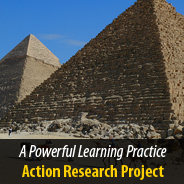What does 21st century communication and collaboration look like? Does the use of technology affect/increase the understanding and cultural proficiency of students?
Essential Question: How has technology influenced the way we create peaceful solutions to problems?
- Students brainstorm and create list of current scientific advances and topics in the news
- Students visit class wiki (created by teacher) with resources on topics generated
- Students reflect on essential question after reviewing wiki
- Students visit You Think website. Select issue that most interests you to learn more about. Is there a solution that you can offer that might address the issue you selected?
- Consider how you would go about tackling this issue (make sure it addresses our essential question) Who might you contact that could provide more information or help? What would you design? What is the issue you chose to address? How would it create a peaceful solution?
- View TED Talk on Innovation and one on Design. (See below)
- Using Text2MindMap create an outline with the information you have discovered. Use that web to reflect on how your creation can be a peaceful solution to a problem.
- Create a page using Solvr. With a partner, share turns discussing your ideas. Remember to use distinguished dialogue. (If it is not helping…it is hurting) Be sure to make recommendations by asking “Have you considered?” Use that discussion to reflect on how your idea can be a peaceful solution to a problem
- Log into iEarn Project Collaboration Center, introduce self and post essential question.
COLLECTIVE ACTION:
- Students will share their work on grade level wiki, and collaborate with out of state class working on same topic.
- Students will Skype with various classrooms (KS, IL) on topic
- Students will contribute to a wiki on related topic with peers from Kansas (Illinois).
- Students will collaborate with global peers through iEarn (Egypt, Pakistan, Oman)
This lesson was structured for student independence. The first application of the lesson required a reframing of student ideas about learning. Students were hesitant to begin and asked for clarification and specific directions. Reassurance and confidence building, group and individual conferencing empowered students. I attempted to use an online application for goal setting and communication but it proved to be too much. We discussed goals in large and small groups instead.
Students soon became independent and were able to identify their daily goals. They asked for time away from the computer to think. Next quarter I will implement a hands-on problem solving component to engage students physically.
Our original plan was to participate in an already developed forum through iEarn. This involved responding to questions that revolved around a lesson plan that a teacher had submitted. We began by doing this then soon recognized that we were in conversation with students from Egypt during their governmental and political crisis. We refocused our question and asked students; how do YOU think technology may create a peaceful solution to your county’s problem?
The discussion resulted in great dialogue yet conflicting perspectives. Egyptian students painted a different picture of what we perceived was happening in Egypt. This lead to an American student Skyping and Egyptian student late one evening. Another American student is contributing to a project of an Egyptian student supporting her project efforts.
Notes:
- Include hands-on problem solving component to engage creative thinking
- Look for tool to collaborate and personal goal set with students
- Look for or create Skype opportunity for class
- Culminating activity to bring it all together
You can find links to many of the resources used for this project on the
team’s wiki page.


